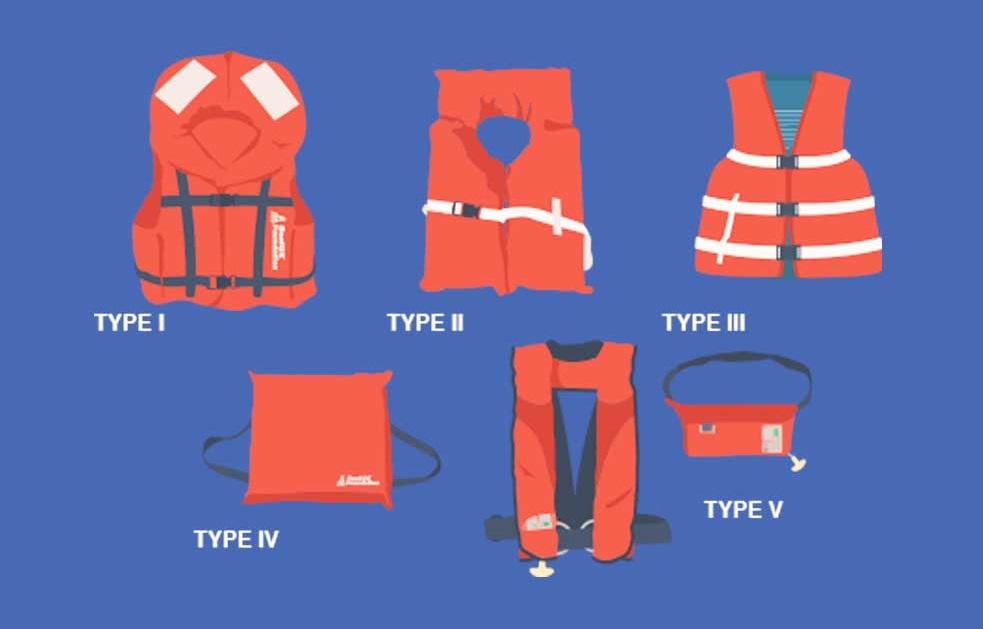Type I, Type II, Type III, Type IV, Type V, and Inflatable PFDs
The United States Coast Guard (USCG) has developed specifications and criteria for approved personal flotation devices or PFDs as they are known. Every PFD will have a label or printing directly on the device identifying the Type of PFD, the size (or weight) individual it is designed for, and any other pertinent information. Below are the different specifications for each type of PFD.
Note:
Due to the changes in technology and water sports popularity, the USCG is going to be revising these PFD Specifications in the near future.
1. Type I PFD: Off-Shore Life Jacket
Type I PFDs provide the most buoyancy, and are designed for offshore and rough water conditions. They come in two sizes, adult and child. The child size is designed with at least 11 pounds of buoyancy while the adult size has at least 22. The main functional feature of the Type I PFD is that it is designed to float unconscious victims in the face-up position. The disadvantage is that it is quite bulky and not all that comfortable to wear if you are really active on the boat.
2. Type II PFD: Near-Shore Life Jacket
Type II PFDs are intended for use in inland waters where there is a reasonable chance of a speedy rescue. It is for relatively calm inland water. These are your typical orange life jackets that are in the shape of a “U.” They fit over a person’s neck and come down on each side of the chest. This is commonly (but not necessarily fondly) known as the horse collar.
Type II PFDs will usually turn some unconscious victims to a face-up position. These PFDs provide between 7 to 15.5 pounds of buoyancy, depending on infant to adult sizes. The downside with this PFD is that it is uncomfortable (especially around the top of the neck) and it provides none of the insulation value that other PFDs commonly do.
Beyond some specific children’s sizes, one size in the horse collar pretty much fits all. You can pick up some version of this one at just about any discount sporting goods store. This PFD is so uncomfortable that most people are tempted to take it off. Once it’s off, it’s awkward to get back on so, in a crisis, it is effectively useless to you. If you plan on doing anything more than lily dipping around the local pond, skip this one and buy something you will wear.
3. Type III PFD: Flotation Aid
Type III PFDs are designed for inland conditions. These are usually the PFDs worn for specific activities such as fishing vests and kayaking life jackets. They are designed for comfort, continuous wear, and for maximum mobility. As such, they probably won’t turn the wearer to the face-up position in the water. Rather, they tend to float wearers in the vertical position. The definition of Type III PFDs usually contains the word “calm” to describe the water conditions they are meant for. This would be functionally incorrect as most whitewater PFDs, that is those worn by whitewater kayakers and whitewater canoeists, are Type III PFDs.
4. Type IV PFD: Throwable Device
Type IV PFDs are carried on boats as a device that can be thrown at a drowning person. These are either circular rings found on commercial boats or around swimming pools. On recreational motor boats, these take the form of seat cushion-style devices. They are not meant to be worn.
5. Type V PFD: Special Use and Hybrid Devices
Type V PFDs are intended for specific activities and must be used in accordance with the specifications on their labels. Some of the features that may be included in these devices are hypothermia protection, inflatable portions, and work vests.
6. Inflatable PFDs: Types I-III
Inflatable PFDs are becoming more popular and prevalent. They are the most comfortable type of life jacket but they do have their downsides. Inflatable PFDs offer no flotation until they are inflated. They are not to be used where impact and high speeds are encountered as this can damage the inflation mechanism and in these conditions, the person wearing the PFD may be knocked unconscious before they are able to deploy the inflation feature. These are also not recommended for use by children.
Inflatable PFDs are great for use in recreational kayaking and kayak fishing. They come in Type I, Type II, and Type III PFD specifications and are intended for use following the same guidelines.

